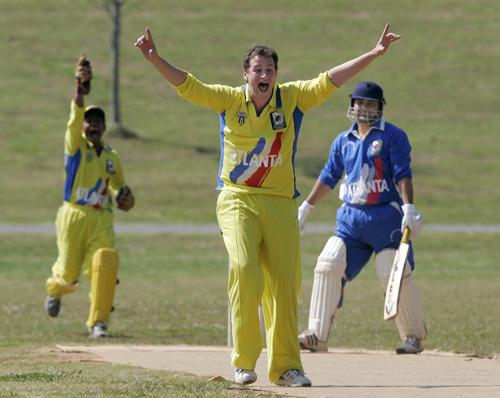Cricket’s popularity increasing in America

James Maskell, foreground, reacts during a cricket match Saturday, in Marietta, Ga. Cricket, that sport of bowlers and wickets and five-day-long games, has gained a toehold in this land of baseball, hot dogs and apple pie. Increasingly, immigrants from co Laura Prusik
Apr 25, 2007
MARIETTA, Ga. – If every day could be like this: The sun is warm and soothing, the sky is painted a brilliant shade of blue and there’s not even the wisp of a cloud to get in the way.
And right in Atlanta’s suburbs stands a large patch of neatly trimmed grass. Ahhh, the perfect place to break out those bats and balls.
Yep, it’s time to play some cricket.
The sport of googlies and wickets, of five-day games and breaks for lunch and tea, has gained a toehold in this land of baseball and apple pie. Increasingly, immigrants from countries as diverse as England and Bangladesh are congregating in neighborhood parks, setting up pitches and reconnecting with lands left behind.
“I do follow sports like baseball and football and basketball,” said Sharma Vedula, who came to the United States from India in 1990. “But this is the one game that takes you back to your home country, at least for a day.”
Get The Daily Illini in your inbox!
Arguably the world’s second-most popular sport behind soccer, cricket has millions of fans eagerly awaiting its showcase event, the World Cup final, scheduled for Saturday in Barbados.
But the seven-week, 16-team tournament was largely ignored in America except for the lurid death of Pakistan coach Bob Woolmer following the cricket-mad nation’s failure to advance to the second round.
Now, mainstream America is focused on the NBA playoffs, A-Rod’s hot start, the umpteenth hour of televised poker and this weekend’s NFL draft. Who’s got time for cricket when the Steelers are on the clock?
“There’s certainly a cultural barrier,” said James Maskell, an Englishman who moved to the Atlanta area two years ago. “Do I think it will ever be genuinely popular here? Probably not.”
But there’s a whole subculture adding stitches to the red, white and blue fabric, folks who cling to their national pastime even as they put down roots in America. They’re keeping up with the World Cup over the Internet or with special TV packages, and they’re playing the game, too.
The Atlanta Georgia Cricket Conference has grown to 18 teams, manned by weekend warriors who dole out hundreds on fees and equipment (a good bat, flat on one side, can cost as much as $400). Sundays are reserved for games, which generally consume most of the afternoon – five to six hours minimum.
They don’t come close to matching the influx of Latin Americans who have transformed soccer into an leisure-time phenomenon north of the border. But cricket has a strong following among those who emigrated from the former British Empire to the ex-colony that came up with its own bat-and-ball game.
Last weekend, North Atlanta traveled to Marietta to take on the J.P. Gymkhana Cricket Club, which was allowed to build its pitch on a vacant section of a five-field softball complex after lobbying country officials.
“We had to really explain it to them,” Vedula quipped.
North Atlanta arrived in new uniforms – bright yellow – while Gymkhana wore blue. The quiet afternoon was frequently punctured by the shouts of excited players from all corners of the globe, chattering away in various languages.
In the middle of the oval-shaped field, there’s a 22-yard-long strip of packed dirt, which is where the bowler bounces the ball toward the batsman. Wickets stand at each end, the all-important wooden pegs that must be defended by the batting team. The outer boundary is staked out by small red tags, the kind the water company leaves when it’s about to dig up a yard.
“We work all week,” said Sabbir Mhmud, a native of Bangladesh who plays for North Atlanta. “Sunday is for fun.”
The North Atlanta team is a downsized version of the U.N. In addition to Bangladesh, the players hail from India, Pakistan, Jamaica and England – a diverse group that puts aside cultural differences and any simmering rivalries. India and Pakistan may be blood enemies on the subcontinent, but they get along just fine in Dixie.
“We don’t want to create that kind of image,” said Hashim Ahmadani, who arrived from Pakistan in 2002. “We’re just playing for fun.”
Actually, they’re pretty serious, which was evident when two North Atlanta teammates exchanged tense words over a botched play. Still, there’s a bond among players, no matter the team colors or country of origin.
They’ve all felt the disconcerting looks of Main Street America, which sees them as a threat to its way of life. Imagine how a xenophobe might have reacted to seven Muslin players – four from North Atlanta, three from Gymkhana – dropping to their knees to pray toward Mecca during a break in the match.
But one of the Gymkhana players wore an Atlanta Braves cap. Mhmud’s favorite team is the NBA’s Los Angeles Lakers. Ahmadani took up baseball when his north Georgia high school put out a call for left-handed pitchers. Jamaican native Matthew Evans sounds like the typical University of Georgia student who can’t wait for football season.
“I used to hate it,” he said, “but going to school there I’ve grown to love it.”
Of course, cricket is his first love, just as it is for the two dozen-odd players who turned out this day. They cherish the elegance, complexity and eccentricities, even if passing motorists have no idea what’s going on.
“From an American perspective, it might seem like it takes a long time to play a game,” said Maskell, who dabbed sunscreen on his fair skin. “But it’s very much a thinking man’s game. It’s a combination of skill and also being able to concentrate over long periods of time.”
His American girlfriend, Rachel Rivera, was downright confused when Maskell first showed her a cricket match on DVD. Now, she’s getting the hang of it.
“It’s very different from the common American sports, so it’s fun to watch,” said Rivera, who spread her blanket on a slope next to the field and was joined for a while by two friends.
That said, American cricket is hardly on the verge of challenging baseball, football or even hockey. There are only about 12,000 senior players, and the U.S. has never qualified for the World Cup – a surefire way to increase interest.
Also, the International Cricket Council suspended America’s governing body last month in a dispute over how it runs the sport, cutting off much-needed funding that could have spruced up this wicket wasteland.
Those matters are of no concern to the guys in the Atlanta Georgia Cricket Conference. They already have what they need to make a game of it.
“It’s great to just hang out on a Sunday,” Evans said, “and just play some cricket.”





